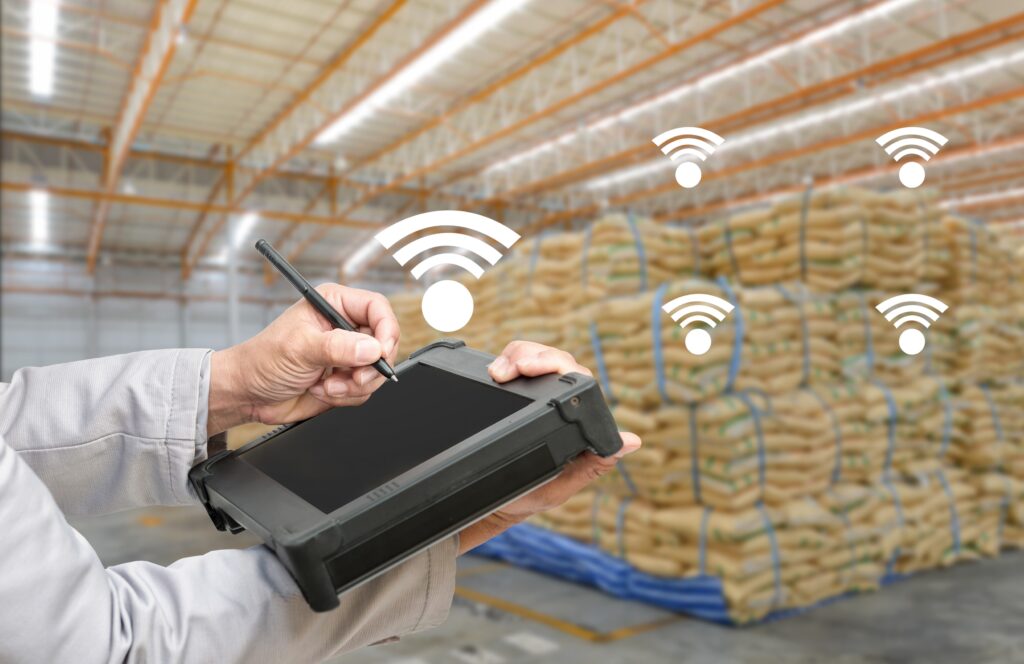A beacon is a small device that uses Bluetooth Low Energy (BLE) to send signals to nearby devices. These signals can trigger actions like sending notifications or providing location-based information. In this article, we will explore what a beacon is, how beacons work, and their many uses.
What are BLE Beacons?
Bluetooth beacons are small, battery-powered devices that transmit signals via Bluetooth Low Energy (BLE). At regular intervals, these beacons emit data packets, triggering specific actions on nearby Bluetooth-enabled devices. By bridging the physical and digital worlds, they enable devices to recognize and interact with their surroundings using Bluetooth low-energy beacons.
The primary function of a Bluetooth beacon is to transmit a unique identifier that provides contextual information to nearby devices. This identifier can be used to deliver personalized experiences, such as sending promotions to a shopper’s smartphone when they enter a store or guiding a visitor through a museum exhibit.
Bluetooth beacons enable user experiences by facilitating seamless interactions between mobile devices and the physical world. As technology evolves, these applications are expanding, offering fresh opportunities for businesses and consumers.
Evolution of Bluetooth Beacon Technology
The journey of Bluetooth beacon technology began with the development of Bluetooth itself in 1989 by Dr. Nils Rydebeck and Dr. Johan Ullman. However, the real turning point came in 2010 with the release of Bluetooth Low Energy (BLE). BLE provided a power-efficient communication method, laying the foundation for modern beacon technology.
Apple’s introduction of the iBeacon protocol in 2013 marked a significant milestone, spurring widespread adoption of Bluetooth beacons. Google followed with the Eddystone protocol in 2015, expanding options for developers. By 2014, over half of the top 100 US retailers experimented with beacon technology, highlighting its rapid growth and potential.
The development of standards like iBeacon and Eddystone ensured interoperability and broadened the scope of beacon applications. These advancements, along with the creation of the Physical Web, have significantly bridged the gap between physical and digital interactions. The introduction of the Eddystone-EID standard in 2016 further enhanced beacon capabilities with features like encrypted identifiers.
How Bluetooth Beacons Work
Bluetooth beacons continuously emit Bluetooth signals containing a unique identifier, which can trigger predefined actions on nearby devices. These signals are broadcasted using radio waves, typically at regular intervals, and consist of short packets of data that nearby devices can pick up. Operating in the 2.400–2.4835 GHz ISM band, these beacons ensure low power consumption while maintaining effective communication.
When a Bluetooth beacon transmits a signal, it sends out a radio signal composed of letters and numbers. This signal can be received by any compatible device within range, allowing it to perform specific actions based on the data received to transmit data. The beacons function as one-way transmitters, broadcasting their identifier to any listening device.
To understand how Bluetooth beacons function, one must consider their signal transmission, components, and battery life. Each aspect significantly influences the beacons’ overall effectiveness.
Signal Transmission and Range

Bluetooth beacons operate within a radio frequency range of 2.400 to 2.4835 GHz, part of the ISM band. The transmission of signals relies on minimal obstructions, as physical objects can significantly impact signal strength and reliability. The typical operating range of Bluetooth beacons varies from 2 to 80 meters, although most beacons have a reliable transmission distance of up to 30 meters.
Beacons can be configured for beacon signal strength and transmission intervals to achieve desired coverage. Although the theoretical maximum range is under 100 meters, practical limitations like obstacles and interference typically reduce this distance. Proper placement and configuration are crucial for effective communication and coverage.
Components of a Bluetooth Beacon
The internal components of a Bluetooth beacon typically include a microprocessor, a radio, and a battery. These elements work together to transmit signals efficiently and cost-effectively. Additionally, many beacons come equipped with sensors such as accelerometers to enhance their functionality.
The simplicity of these components makes Bluetooth beacons easy to maintain and deploy in various settings.
Battery Life and Maintenance
A major advantage of Bluetooth Low Energy technology is its long battery life. Due to their energy-efficient design, BLE beacons can operate for years on a single battery. They usually use small lithium chip batteries or connect to power sources like USB plugs. BLE technology’s low power consumption, using only 1-20% of the power required by full Bluetooth, further extends battery life.
However, the range and frequency of signal transmissions affect battery consumption. Higher signal strength and more frequent transmissions can deplete the battery faster. Regular maintenance, including battery replacement, ensures continuous operation.
Despite these challenges, the long operational duration and low maintenance requirements make BLE beacons a practical choice for many applications.
Key Features of Bluetooth Beacons

Bluetooth beacons are characterized by their low power consumption, compact size, and ease of deployment. These features enable beacons to operate for extended periods, with some models lasting several years on a single battery. These devices’ compact and lightweight design makes them easy to install in diverse environments, from retail stores to industrial sites.
Another significant feature is their ability to transmit signals over a typical 2 to 30-meter range without requiring an internet connection. This makes them ideal for applications where continuous connectivity might not be feasible. As standalone broadcasters, Bluetooth beacons can effectively bridge the gap between physical locations and digital interactions.
Benefits of Using BLE Beacons

BLE beacons offer numerous benefits, making them a cost-effective solution for businesses. These low-cost devices enable companies to deliver personalized experiences without substantial investments. Integrating BLE beacons with IoT technologies enhances location-based services, creating new opportunities for tailored consumer interactions.
Bluetooth beacons improve customer engagement through real-time, relevant notifications and promotions. Retailers can send targeted messages and offers based on customer proximity, influencing purchase decisions and enhancing marketing results.
Additionally, BLE beacons provide detailed insights into customer behavior, supporting analytics that can refine marketing strategies and boost sales.
Real-World Applications of BLE Beacons

BLE beacon technology has found its way into various real-world applications, significantly impacting industries such as retail, healthcare, and smart buildings. Beacons enhance proximity marketing and customer engagement in retail, influencing billions in sales. They bridge the gap between online and offline channels, creating a seamless customer journey.
AiRISTA offers a comprehensive range of BLE solutions for different applications, including asset tracking, personnel tracking, and environmental monitoring. These beacons are increasingly used in smart buildings to improve localization and engagement, showcasing their versatility and effectiveness.
The BLE beacon market is expected to grow at a compound annual growth rate (CAGR) of 7.1% from 2024 to 2031, driven by their expanding implementation.
Retail and Proximity Marketing
Retailers leverage Bluetooth beacons to enhance proximity marketing by sending customized messages and offers directly to customers’ mobile devices based on their location. This use of beacons in retail stores allows for personalized promotions and improved customer engagement, creating a more interactive shopping experience.
The adoption of Bluetooth beacons in retail has grown significantly, driven by their ability to provide timely and relevant information to shoppers. By enhancing the overall shopping experience, beacons help retailers boost customer satisfaction and loyalty.
Indoor Navigation
Bluetooth beacons are crucial in indoor navigation, providing real-time guidance within venues like museums, airports, and theme parks. For instance, at Disneyland, beacons help guests navigate the park using an interactive map, offering a customized experience based on their preferences.
Museums like the Asian Art Museum use beacons to provide visitors with immediate access to exhibit information based on their current location. This enhances the visitor experience by delivering targeted content and special deals at nearby shops, making their visit more informative and enjoyable.
Asset Tracking and Management
In industrial settings, Bluetooth beacons are invaluable for real-time asset location tracking, enhancing inventory management and operational efficiency. AiRISTA’s BLE Asset Tag, designed for effective asset tracking, features a compact form and communicates over existing wireless infrastructure.
The seamless integration of BLE Asset Tags into asset management systems ensures accurate tracking and management of valuable resources. This not only enhances operational efficiency but also reduces the risk of asset loss or misplacement, contributing to better overall management.
AiRISTA’s BLE Beacon Solutions
AiRISTA is a leading provider of comprehensive BLE beacon solutions, catering to various industries with a range of products designed for specific applications. Their offerings include BLE devices optimized for asset tracking, personnel tracking, and real-time detection. AiRISTA’s Bluetooth beacons are compatible with both Cisco Spaces and HPE Aruba’s solutions as well as various WLAN BLE enabled APs, ensuring seamless integration and interoperability.
The company’s solutions are tailored to meet the unique needs of different sectors, providing robust and reliable performance. AiRISTA’s commitment to innovation and quality makes their BLE beacons a preferred choice for businesses looking to enhance their operations with advanced location-based technologies.
BLE Asset Tag (A1)
The BLE Asset Tag (A1) by AiRISTA is designed for efficient asset tracking, incorporating features like an accelerometer for enhanced responsiveness. Its compact design makes it ideal for various applications, providing accurate and reliable tracking of assets.
This tag functions as both a BLE transmitter and receiver, facilitating the association of people with assets and improving overall management. Its integration into existing systems ensures seamless operation and enhances asset tracking efficiency.
BLE Personnel Tag
AiRISTA’s BLE Personnel Tag is designed to enhance the safety and tracking of personnel in various environments. Equipped with a high-capacity battery and a button for quick notifications, this tag ensures the safety of staff members by enabling rapid responses to emergencies.
The BLE Personnel Tag also acts as a receiver, scanning for neighboring beacons to associate people with assets, thereby improving safety and operational efficiency. This makes it an essential tool for maintaining safety and enhancing workflow in demanding environments.
BLE Beaconing Gateway Unit (BGU)
The BLE Beaconing Gateway Unit (BGU) serves as a critical component in AiRISTA’s BLE beacon ecosystem. Acting as both a BLE beacon and receiver, the BGU gathers data from nearby BLE devices to facilitate accurate location detection and real-time monitoring. This dual functionality makes it an invaluable tool for comprehensive proximity-sensing applications.
By connecting multiple BLE beacons, the BGU can extend coverage and provide extensive area monitoring. It supports standard BLE beacon protocols, including iBeacon, Eddystone, and AiRISTA’s proprietary beacons, ensuring compatibility and ease of integration.
Comparing BLE Beacons with Other Wireless Technologies

Bluetooth beacons offer several advantages over other wireless technologies. Compared to NFC beacons, which have an operational range of less than 20 cm, BLE beacons provide a significantly longer range while maintaining low power consumption. They also outperform RFID beacons in terms of operational range.
While Wi-Fi beacons offer high location accuracy and extended range, they consume significantly more power and are more costly to deploy. LoRa beacons, capable of long-range communication up to 15 km, operate at a lower data rate, making them less suitable for high-speed data transmission.
BLE beacons strike a balance by offering a decent range, low power consumption, and cost-effective deployment.
Challenges and Limitations of BLE Beacons
Despite their benefits, BLE beacons face certain challenges and limitations. Signal interference from other devices operating on the same frequency can affect detection accuracy. Environmental factors such as thick walls or severe weather can also compromise the reliability of beacon signals.
Battery life is another consideration, as higher signal strength and frequent transmissions can lead to quicker battery depletion. Additionally, BLE beacons cannot determine the direction of users and may struggle to track moving devices accurately. Addressing these limitations requires careful planning and deployment to ensure optimal performance.
Future Trends in BLE Beacon Technology
The future of BLE beacon technology looks promising, with several emerging trends poised to enhance their capabilities. Integration with IoT, AI, and real-time location systems is expected to drive innovation, offering more precise and efficient location-based services. BLE beacons will continue to bridge online and offline experiences, making everyday objects smarter and more interactive.
Expected advancements include smarter offline objects such as bus stops, vending machines, and shopping malls equipped with BLE beacons. Technologies like Mapsted, which offer beacon-like accuracy without additional hardware, are also on the horizon, promising to revolutionize the way we interact with our environment.
Summary
Bluetooth beacons, leveraging Bluetooth Low Energy technology, have revolutionized how we interact with the physical world. Their compact design, cost-effectiveness, and low power consumption make them ideal for various applications, from retail and proximity marketing to indoor navigation and asset tracking. AiRISTA’s comprehensive range of BLE beacon solutions showcases the versatility and effectiveness of this technology.
As we look to the future, the integration of BLE beacons with emerging technologies promises to unlock new possibilities and enhance our daily experiences. Businesses and individuals alike can benefit from exploring the potential of BLE beacons, driving innovation and connectivity in an increasingly digital world.
Frequently Asked Questions
What are beacons, and how do they work?
Bluetooth beacons are small, battery-operated devices that transmit signals at regular intervals using Bluetooth Low Energy (BLE) technology. They facilitate location-based interactions by triggering predefined actions on nearby BLE-enabled devices when within range.
What are the key features of BLE beacons?
The key features of BLE beacons include low power consumption, compact size, ease of deployment, and the capability to transmit signals over a distance of 2 to 30 meters without needing an internet connection. These features make them highly effective for various applications.
How are BLE beacons used in retail and proximity marketing?
BLE beacons are utilized in retail to deliver personalized messages and offers directly to customers’ mobile devices when they are nearby, significantly enhancing engagement and the overall shopping experience. This technology fosters a more interactive and targeted approach to marketing.
What are some challenges associated with using BLE beacons?
The challenges of using BLE beacons include signal interference from other devices, environmental factors impacting signal reliability, concerns regarding battery life, and limitations in accurately tracking moving devices. These issues can hinder effective implementation and user experience.
What future trends can we expect in BLE beacon technology?
We can expect BLE beacon technology to integrate increasingly with IoT and AI, enhancing the interactivity and smart capabilities of everyday objects while also improving location accuracy without reliance on extra hardware. This evolution will significantly improve user experiences across various applications.





